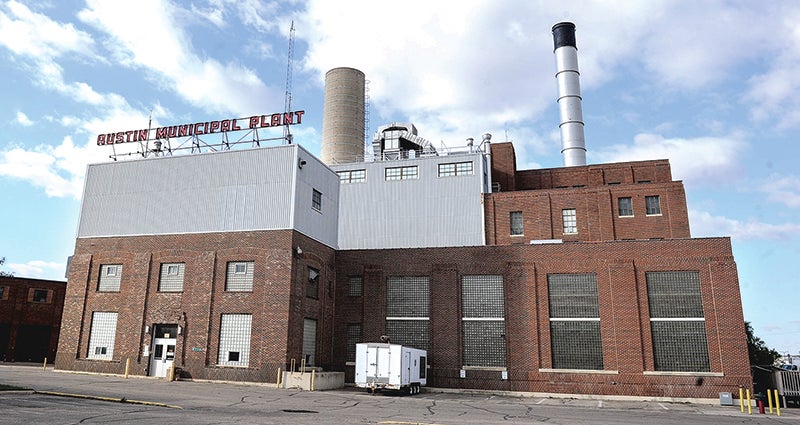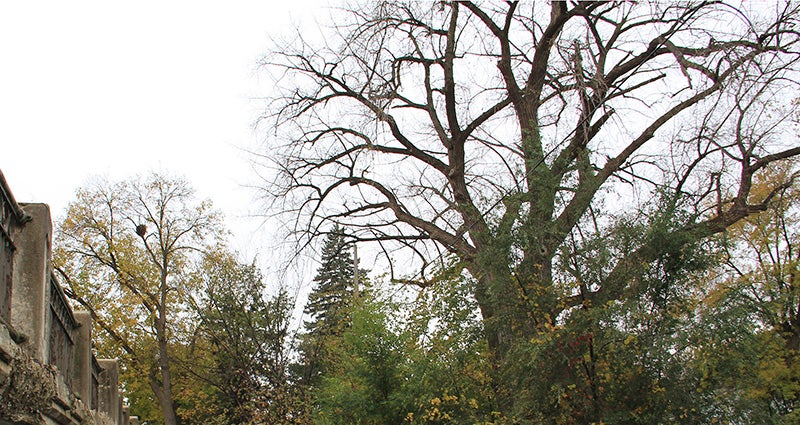An investment in tomorrow’s cures; Leaders help kick off Hormel Institute’s $28.5-million expansion
Published 11:13 am Thursday, May 29, 2014
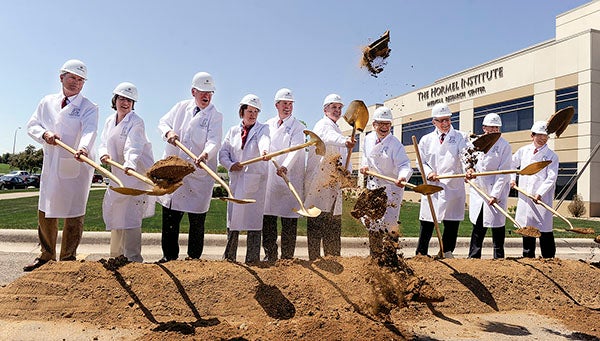
Diginitaries pitch shovel-fulls of dirt as ground is broke for the new Hormel Institute expansion during a ceremony Wednesday. Eric Johnson/photodesk@austindailyherald.com
Dignitaries and state and regional leaders gathered yesterday to celebrate and kick off a project they called an investment in Austin, in The Hormel Institute and in our nation’s future.
Hormel Institute leaders, Gov. Mark Dayton, U.S. Sens. Amy Klobuchar and Al Franken, and more than 300 people gathered outside The Hormel Institute Wednesday afternoon to break ground on the $28.5-million expansion that will add 20 state-of-the-art laboratories and better space for the Institute’s International Center of Research Technology.
“Together we make history,” Executive Director Dr. Zigang Dong said. “Together we grow our Institute, our university, our state, our country.”
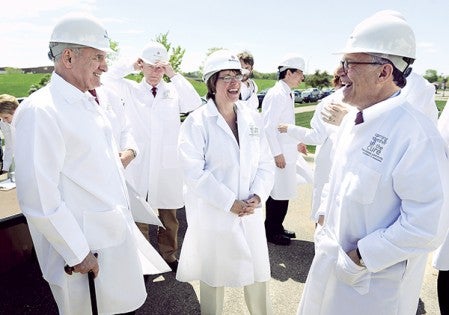
Governor Mark Dayton, from left, Senator Amy Klobuchar and Sen. Al Franken share a laugh before the groundbreaking for the Hormel Institute expansion Wednesday afternoon.
Institute leaders expect to add about 120 jobs over the next few years, growing the Institute to a total of about 250 employees.
“These are going to be great jobs,” Dayton said, adding that such positions will attract people that will be vibrant additions to the community.
Investing in Austin
To Hormel Foundation Chairman Gary Ray, the project represents an exciting future for the Institute, which will bolster contributions to the economy, draw educated people to the workforce, help improve schools, and give local children possibilities close to home.
“There’s tremendous opportunities here that The Hormel Institute is creating,” he said.
In the spirit of Vision 2020’s community betterment effort, the expansion will improve the community and be a source of pride, while also attracting some of the world’s leading scientists to Austin.
“It enhances our reputation as an attractive, diverse destination,” Ray said.
That’s one reason the Hormel Foundation has invested $70 million in The Hormel Institute in the last decade, according to Ray.
The Hormel Foundation committed $15 million to the expansion and an additional $8 million to recruit scientists.
“The Institute is truly living up to the promise of its slogan: Today’s Research, Tomorrow’s Cure,” Ray said.
“We believe in what it’s doing to beat cancer,” he added.
Ray said the Hormel family, which formed the foundation, would be proud.
“This is what George and Jay Hormel envisioned back some 70 years ago,” he said.
An investment in our nation and our future
To Klobuchar and Franken, the Institute expansion represents an investment in the nation’s future, as the senators promoted research and development as a way to bolster America’s competitive edge and make for a healthier future.
“We are shortchanging the future if we don’t invest in this research,” Franken said.
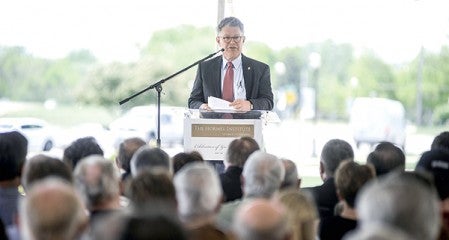
Senator Al Franken speaks Wednesday during a ground-breaking ceremony for The Hormel Institute expansion. Eric Johnson/photodesk@austindailyherald.com
Franken called research and development a pillar of the country’s future prosperity.
“Our investment in research is the key to the country’s success, not just in medicine, but in agriculture and in energy and in our space program,” Franken said.
Klobuchar stressed the importance of funding the National Institutes of Health, which provided $1.1 million in grants to the Institute last year to research how compounds in tea fight cancer and if a diabetes drug prevents breast cancer tumors. NIH funding supported more than 8,000 jobs in Minnesota in 2012, she said.
“This kind of work has to continue,” Klobuchar said.
Research, Klobuchar said, creates jobs in Minnesota and is important for the people and families fighting cancer.
“We’re excited to keep funding the research and we want to fund even more,” Klobuchar said.
Klobuchar said the Institute is representative of innovation across Minnesota, as the state boasts the Mayo Clinic, research that brought the pacemaker and more. She said it’s not an easy time in politics, business or academics, but the expansion is an example of celebrating when things are done right.
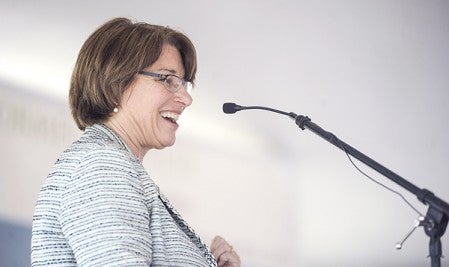 Klobuchar praised Hormel President and CEO Jeffrey Ettinger for supporting immigration reform, which she said will be key in bringing scientists to Austin.
Klobuchar praised Hormel President and CEO Jeffrey Ettinger for supporting immigration reform, which she said will be key in bringing scientists to Austin.
“We really need to change that to continue this work, so we have more jobs right here in America that are not only jobs for the people in Austin, but jobs for people all over the world,” Klobuchar said.
She said Dong is an example of an immigrant coming to the U.S. and starting something amazing.
Superb research
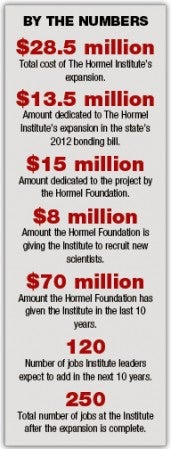 Dr. Brian Herman, vice president of research at the University of Minnesota — one of the Institute chief partners, said the Institute continues to make good on its charge to “sow the seeds of innovation around the globe.”
Dr. Brian Herman, vice president of research at the University of Minnesota — one of the Institute chief partners, said the Institute continues to make good on its charge to “sow the seeds of innovation around the globe.”
“Here at the Institute, the quality of research is superb,” he said.
The Institute has published research in prestigious journals like “Science” and “Nature,” and Herman commended scientists for already making fundamental discoveries to fight cancer, especially in chemo preventatives — often through natural food products.
And the future is bright.
“The promise for greater significance is very, very strong,” Herman said.
Herman said collaborations like the one between the Institute, the University of Minnesota and the Mayo Clinic are vital to the success and future of the field and the Institute, and he also mentioned a partnership with IBM’s supercomputer currently used at the Institute.
“Collaboration is paramount,” Herman said.
Key Partnerships
Herman also said public-private partnerships are important to keep “scientific gems” like the Institute operating.
Dayton described the Institute project vital economic growth partnership between the public and private sectors, as he argued the project shows that state government can work with the private sector to make positive contributions to the local and state economy.
“There is a role for government,” he said.
It was a day for leaders to thank Dayton for making the expansion one of the top three projects of the 2012 session and to thank state legislators like Rep. Jeanne Poppe, DFL-Austin; Sen. Dan Sparks, DFL-Austin; Sen. Dave Senjem, R-Rochester; and former Rep. Rich Murray, R-Albert Lea, for their bipartisan support to secure $13.5 million in the 2012 bonding bill.
Several people, including Dayton, praised Senjem for giving the project Republican support.
“It wouldn’t have happened without that bipartisan support,” Dayton said.
Senjem praised Poppe and Sparks for their work in securing the funding for the project.
Even with the Mayo Clinic and the upcoming Destination Medical Center project, Senjem said the Institute is special.
“It’s good people coming together and making really, really good things happen,” Senjem said.
In the Senate, Senjem said the Hormel Institute expansion was the No. 1 project for the 2012 bonding bill.
“Let this be the place where the best of science comes together for the betterment of humanity,” Senjem said.
When does work start?
Craig Jones, manager of research support services and the project’s building coordinator, confirmed work should start around June 23. First, crews will take out the current parking lot on the east side of the building to start laying the groundwork for the expansion. They’ll also level the old houses across Eighth Drive Northwest to start on the new parking lot.
Jones led the Institute’s $23.4-million expansion from 2006 to 2008, which tripled the size and took the Institute from 60 to 120 employees.
To Jones, the second expansion isn’t any less exciting.
“It almost seems like a bigger deal this time,” he said.
The expansion is scheduled for completion in August of 2015.
The Road to Expansion
1941 — The Hormel Foundation is founded by Jay C. Hormel, the second CEO of Hormel Foods Corp. and the son of its founder, George A. Hormel. For many years, The Hormel Institute is the sole recipient of the foundation’s funds, outside of the Hormel family.
1942 — The Hormel Institute is founded on Nov. 20 by Jay C. Hormel, with a mission to conduct research in biological sciences with applications in medicine and agriculture. The Hormel Foundation enters into an agreement with the University of Minnesota to operate a 400-square foot biological research lab in the horse stables of the Hormel family’s estate outside of Austin. The estate is now Gerard Academy.
1943 — H.O. Halvorson, Ph.D., becomes The Institute’s first executive director. Halvorson serves as an advisor to Jay Hormel on food stability.
1949 — Walter O. Lundberg, Ph.D., becomes its second executive director, serving for more than 25 years.
1960 — The Hormel Institute moves in June from its original location in the horse stable, now at 12,000-square feet not counting animal barns, to its current location at 801 16th Ave. NE, next to Hormel Foods’ corporate headquarters. Its new home has 10 labs to start.
1963 — Dr. Ralph T. Holman first names Omega-3 fatty acids in a scientific journal. He also names Omega-6 fatty acids. His work involves collaboration with people all over the world and from 15 different countries.
1960s — The Institute supplies “Arnold” the pig for the TV show “Green Acres.” The show aires from 1965 to 1971.
1975 — Holman becomes The Institute’s third executive director.
1981 — Holman is named to the National Academy of Sciences in Nutrition.
1985 — Harald H.O. Schmid, Ph.D., becomes its fourth executive director.
2001 — The Institute names Dr. Zigang Dong its fifth executive director.
2004-2009 — The research of Dong and Dr. Ann Bode, associate director — which makes the world’s No. 1 cancer research journal “Nature Reviews Cancer” — is the most cited in the world in molecular biology for five years.
2006 — A busy year for The Institute, as it signs an agreement for collaboration with Mayo Clinic in Rochester, and breaks ground on a $23.4-million expansion. While the agreement with Mayo is the start of the entities official partnership, a Mayo representative has been on the Institute’s board of directors since the lab’s inception.
2008 — The Institute finishes its expansion, which triples its size and takes it from 60 to 120 employees. The expansion, which opens on Oct. 3, creates 20 new state-of-the-art cancer research labs.
• The Institute partners with IBM, bringing a BlueGene/L Supercomputer to its lab. At the time, it’s the world’s fastest supercomputer.
• The International Carcinogenesis Symposium is held in Austin, attracting cancer researchers from around the world.
• Dong is selected as a National Institutes of Health Merit award recipient.
2011 — The Institute officially announces in October its plans for a $27-million, 74,000-foot expansion, which it says will add 120 jobs.
2012 — Gov. Mark Dayton and the Minnesota Legislature secure $13.5 million for the Institute expansion in the state bonding bill.
2014 — The Institute breaks ground on its latest expansion. Work is slated to begin in June.
2015 — The Institute is scheduled to complete and open its new wing.



